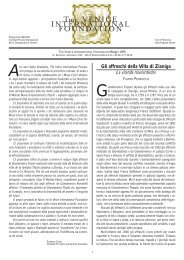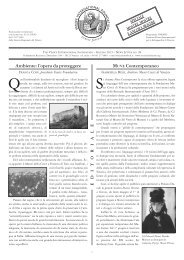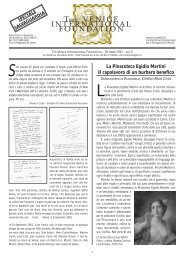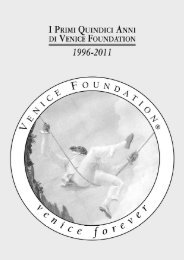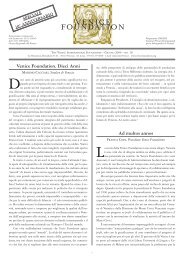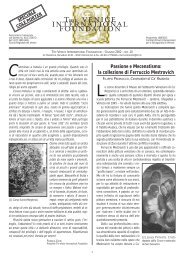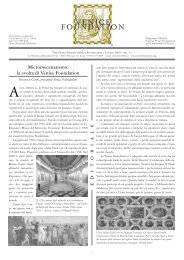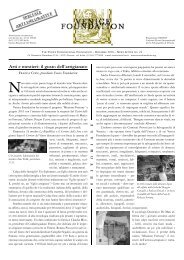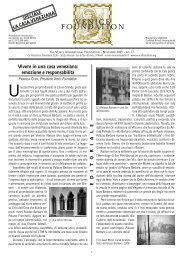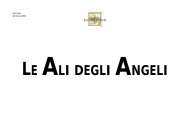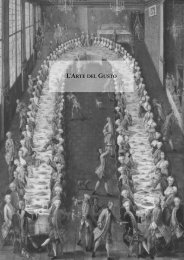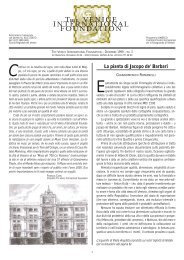Ca' Rezzonico - The Venice International Foundation
Ca' Rezzonico - The Venice International Foundation
Ca' Rezzonico - The Venice International Foundation
Create successful ePaper yourself
Turn your PDF publications into a flip-book with our unique Google optimized e-Paper software.
<strong>The</strong> <strong>Venice</strong> <strong>International</strong> <strong>Foundation</strong>all their eighteenth-century originality, as seen in the grand staircase,the ballroom and the extension to the northern end of thebuilding. <strong>The</strong> latter takes the form of a sort of grand loggia on twolevels, and is completely flooded by light entering through largewindows and illuminating the ceiling. This beautifully designedvault was conceived with great refinement; it closes the playfulcomposition formed of the architectural members and decorativefeatures comprising the walls, stucco decorations, niches andcarved heads on keystones.<strong>The</strong> ballroom was originally formed by uniting two floors ofthe palazzo. Its walls and ceiling are covered in frescoes, with fictivearchitecture and trompe l’œil ornamental features by PietroVisconti, as well as the allegories, mythological figures and, onthe ceiling, <strong>The</strong> Flight of the Chariot of Apollo over the Four Corners ofthe Earth by Giambattista Crosato. In this case restoration andcleaning have brought back the original dominant colour tones:the gilded bronze of the fictive statues, the silver-grey of thecolumns, and the delicate pinks, greens and pale yellows of thetrompe l’œil architecture – loggias, entablatures, consoles and pilasters.It may be said that the architecture, furniture and décor havetogether regained that shining luminosity which belonged to thepalazzo at the height of its glory, and which made an importantcontribution to the fame and success of eighteenth-century<strong>Venice</strong>.<strong>The</strong> variety of different interventions called for the employmentof a wide range of methodological approaches and materials,involving a remarkable number of specialists with diverse professionalskills. <strong>The</strong>se were brought together in a unitary interventionprogramme co-ordinated and undertaken in collaborationwith the Technical Office of the Office of Public Works. Of thevarious interventions, the following were planned and directed bythe Technical Office of the Civic Museums:MASONRY. <strong>The</strong> restoration of masonry commenced with theconsolidation of degraded surfaces by covering them with a layer(velinatura) of Japanese paper and acrylic-silicone resins. Cleaningwas then undertaken using compresses with basic mixes or solvents;ugly and inappropriate repairs were then removed usingscalpels, and resulting gaps were refilled with Lafarge hydraulicmortar and acrylic resins mixed with sand and powdered marble.Surfaces were protected with a nebulised resin, and were finishedwith a microcrystalline wax applied with a brush, buffed with asoft cloth.[29-30] Consolidation of the portal of the first floor portico and a detail of afigure of Atlas by Alessandro Vittoria, treated with wax.C A ’ R E Z Z O N I C O[31-32] Ceiling over the GrandStaircase. Above: Cleaning of thestucco decorations. Below: Repairs tothe ceiling.STUCCO AND PLASTERWORK.Interventions included the examinationof plasterwork andthe consequent removal of sectionswhere these were very degraded.Sections that werecoming away from the wallwere secured with injections ofa compound of common lime,powdered terracotta and marbleand acrylic resin in a waterbaseddispersion. In the case ofthe ceiling, insecure sectionswere anchored mechanically tothe supporting framework. <strong>The</strong>consolidated elements werethen cleaned, unfit repairs wereremoved and any resulting lacunaewere refilled. <strong>The</strong> pictorialsurfaces were then reintegratedand the colour balance was adjusted using watercoloursand, in some cases, using tints based on milk of lime and earthpigments.Cleaning of the surfaces of the stucco decorations was undertakenusing light compresses of Japanese paper with water in abasic solution and appropriate detergents to remove impuritiesand oily deposits; layers of over-painting were removed usingcompresses with solvents and finished with scalpels. Where necessary,remaining over-painting was removed using cellulose pulpcompresses. Surfaces subject to efflorescence were given a protectivetreatment to remove soluble salts with the repeated applicationof deionised water compresses, then micro-injections of abonding solution of acrylic resin in an aqueous dispersion wereapplied along all fissures. Fissures, holes and breaks in the stuccoworkwere made good using stucco paste, following the originalcolours and design. Lacunae in the painted surface were in-paintedusing watercolour glazes in muted tones.WOODWORK. <strong>The</strong> boiseries (wooden panelling, painted intempera with floral designs or geometric patterns – lozenges, volutes,scrolls and other shapes) were cleaned and retouched. Firstly,dust and other loose deposits were removed without the use ofliquids; surfaces were then consolidated with the application of avelinatura and the provisional filling of any holes or cracks; areas offlaking and blistering of the pictorial surfaces were consolidated.<strong>The</strong> surfaces were then given a light wash with de-mineralisedwater, and lacunae in the painted surface were in-painted usingminimally invasive and reversible techniques, a colour glaze wasapplied and the colour balance was adjusted, and finally a protectivetreatment was applied. Wooden ceiling beams were firstcleaned of dust, and were then washed and cleaned of organic materialsand old retouching to the paintwork; after the filling of anycracks, and sanding to remove surface irregularities, retouching wascarried out with a colour glaze. A neutral consolidating treatmentwas then applied, followed by coats of transparent or clear varnish.<strong>The</strong> surfaces of internal doors were cleaned of dust and oily depositsusing the correct proportions of detergent and water andwere then rinsed. Door handles were cleaned of incrustations and7
<strong>The</strong> <strong>Venice</strong> <strong>International</strong> <strong>Foundation</strong>[48-49] Two grisaille scenes depicting Apollonian myths.[45-46] Above: View of the ballroom, the portal leading from the GrandStaircase. Below: View of the ballroom, windows overlooking the internalcourtyard.cupolas. This illusory architecture plays with the perspective togreat effect, seeming to amplify the actual physical space of theballroom.Critics agree on the dating of the frescoes to the period immediatelyafter 1752-53, when nobleman Pietro Gradenigo recordedin his diary that the architect Giorgio Masari was concludingwork on Ca’ <strong>Rezzonico</strong> – works which included the creation of thegreat ballroom. <strong>The</strong> ballroom frescoes therefore represent the firstof the palazzo’s numerous fresco decorations commissioned by Giambattista<strong>Rezzonico</strong> for this, his new family seat. Other frescoesby Giambattista Tiepolo, Gaspare Diziani and Jacopo Guarana,are associated with the marriage of Ludovico <strong>Rezzonico</strong> andFaustina Savorgnan, which was celebrated in January 1758. <strong>The</strong>ballroom fresco also represents the only major decorative schemeby Crosato in <strong>Venice</strong>, aside from his early work on one of thesmaller rooms on the first floor of Ca’ Pesaro. Until the mid-century,Crosato had spent most of his time in Piedmont in the serviceof Vittorio Amedeo II of Savoy, for whom he had worked onthe Royal Palace in Turin, and in the Hunting Lodge at Stupinigi;otherwise he worked on villas in the Venetian terra firma, atMogliano and Mestre. In the last years of his career, Crosato wasactive in the smaller Veneto towns, most notably painting frescoesat the Villa Marcello at Levada near Padua.Crosato reached the peak of his achievement in the fresco ofthe Ca’ <strong>Rezzonico</strong> ballroom. This is demonstrated in the measuredelegance and complexity of the composition of the ceiling fresco,where numerous figures are impressivelysculptural and standout against the blazing sky. Bycontrast with similar scenes by[47] A figure from the edge of thecentral compartment.C A ’ R E Z Z O N I C OGiambattista Tiepolo where the artist’s fantastical Rococo imaginationprevails, the compositional order and decorous form andplacement of the figures of the ballroom ceiling all indicateCrosato’s nascent interest in Neoclassicism. This style is evenmore pronounced in the extremely elegant monochrome trompel’œil reliefs on the upper section of the walls.As the iconographic quotations clearly demonstrate, it is evidentthat the frescoes in the ballroom at Ca’ <strong>Rezzonico</strong> in someway amounted to Crosato’s response to the richly imaginative creationsof Giambattista Tiepolo, the most celebrated and famousfresco painter of the day. In the same period of the ballroom decorationof the Venetian palazzo, Tiepolo was employed atWürzburg, working on his greatest masterpiece, the decorationof the Residence of the bishop-prince of Franconia. In the Venetianfrescoes the independent artistic personality of Crosatostrongly emerges, clearly influenced by the work of the greatBaroque fresco painters of the Emilia region. As a young man,Crosato had spent a period in Bologna where he encounteredthese works which are characterised by an extremely robust andlively palette, by an incandescent luminosity and marked adherenceto naturalism.THE FOUR RESTORATIONS: THE CONSERVATION HISTORYOF THE BALLROOM FRESCOES (Daniela Andreozzi)Prior to their recent restoration, the ballroom frescoes had undergonethree other interventions in the past. <strong>The</strong> earliest of thesewas carried out in the mid-nineteenth-century, probably at thesame time as restoration work was undertaken on the frescoes inthe minor rooms on the first floor of the palazzo which overlookthe Rio di San Barnaba. <strong>The</strong>se interventions also included the retouchingof the painted surfaces with oils, in order to render thecolours more lustrous.<strong>The</strong> second operation was carried out in the early 1900s. It isvery likely that this was the occasion of the installation of an ingenioussystem to consolidate the painted surfaces of the ceiling.With the aim of preventing losses to the plasterwork, the frescoedceiling was secured to the overlying beam structure by almostseven thousand iron screws, affixed to the wooden centrings thatsupport the ceiling and linked together by a copper wire network.<strong>The</strong> restorers had been careful to camouflage these structures,which arose in several parts of the fresco, by the application of silkgauze applied to the metal network, which was coloured in thesame tones as the underlying fresco, rendering them barely visiblefrom below.10
<strong>The</strong> <strong>Venice</strong> <strong>International</strong> <strong>Foundation</strong>C A ’ R E Z Z O N I C O11[51-52] Obvious signs of damage to thefresco before conservation.This superstructure was removed during the course of thethird restoration of the fresco, carried out between 1972 and 1975by Professor Giovanni Giuseppe Pedrocco, thanks to the generousfinancial support provided by the America-Italy Society ofPhiladelphia. On this occasion it was observed how pressure exertedby the iron screws, inserted during the previous restoration andrusted over time, had provoked swelling and breakage in certainof the wooden strips which support the fresco, thereby damagingthe fresco itself, causing the detachment of the painted surface insome places. <strong>The</strong>se wooden strips had suffered further damage,and consequently had become detached from the frescoed plaster,due to the effects of moisture which had infiltrated through theroof, through external walls where plasterwork was damaged andthrough inadequate window frames. A similar problem had arisenwith the frescoes on the ballroom walls. Considerable damage hadalso occurred to the ceiling fresco, both in the central figurativesection and the surrounding decorative elements, caused by movementof roof rafters to which the entire supporting structure wasanchored. And finally, throughout the frescoes there were telltalesigns of the earlier pictorial restorations where extensive areas hadbeen over-painted and the pigments had subsequently oxidized.On this occasion, Professor Pedrocco arranged to remove thesupporting superstructure comprising the iron screws and coppernetwork, described above. Over two thousand brass screws werethen employed to secure the ceiling frescoes to the load-bearingbeams of the ceiling. <strong>The</strong> frescoes were further consolidated by theinjection of a lime–based substance, and only then could the conservatorcommence the careful cleaning of the painted surfaces toremove old over-painting, seeking to recover as far as possible theoriginal chromatic balance. Shading, which Crosato had added asecco after the completion of the fresco, was retouched using temperacolours.Nevertheless, even the latter intervention did not provide adefinitive solution to the most serious problems facing the fresco,which were mainly of a structural nature caused by Massari’s modificationsto the building. Massari created the large ballroom (24m × 14 m) by uniting two floors of Longhena’s original buildingby simply demolishing the walls and floors which subdivided thevarious rooms. This led to a general weakening in the structure ofthis part of the palazzo. In particular, the left-hand corner of theballroom, on entering via the Grand Staircase, has shown signs ofinstability and has moved on several occasions, causing load-bearingbeams to shift and resulting in the “twisting” of the frescoedceiling and the appearance of numerous fissures in the ceiling andwalls.<strong>The</strong> latest incident of this type was observed in May 1993,when some fragments of the frescoed plasterwork fell. Followingthis, Professor Ottorino Nonfarmale proceeded to carry out a carefulexamination of the state of conservation of the fresco. His hypothesesat that time regarding the causes of these losses were re-[50] <strong>The</strong> complete removal of thepavement and floorboards of the thirdfloor over the ballroom allowed theconsolidation of the fresco from aboveand below, by means of resin injections,the renewal of the wooden strips towhich the fresco is attached and theapplication of gauze.cently confirmed in a survey which required the removal of a sectionof the third floor pavement. This survey was undertaken inorder to renovate the beams and the various elements sustainingthe support structure of the ballroom ceiling below. It was confirmedthat the problem of the losses was due in part to the excessivethickness of the plaster employed as the fresco support (6 cm-9 cm) which, rendered thus rigid, cracked as a result of stressesfrom the floor above, to which it is directly tied. Further, the surfacesof the ballroom frescoes were observed to have dulledthroughout and it was difficult to make out the colour shades dueto a layer of dust deposited over the course of time, particularly inthe areas where rainwater had infiltrated.<strong>The</strong> conservation project was drawn up by the Civic Museums’Technical Office. <strong>The</strong> first stage of the intervention, the mostcomplex, concerned the restoration of the ballroom ceiling, whilstthe subsequent stage involved the frescoes on the walls. A series ofpreliminary examinations was carried out involving chemical andstratigraphic analysis and the mapping of deterioration and cracking.<strong>The</strong>se examinations were conducted with the scope of determiningthe most appropriate methods for both the structural intervention,involving the ceiling support system, as well as theconservation of the frescoes. A meticulous ultraviolet photographicsurvey was also undertaken on all painted surfaces, in order todistinguish original painting from subsequent retouching.Preliminary to the restoration work, the exterior walls correspondingto the ballroom were repaired where losses of stuccoand fissures in the wall structure had allowed the infiltration ofwater. A scaffold was then erected, which extended the lengthand breadth of the ballroom, and the unstable parts of the frescoeswere secured with the application of Japanese paper. Cracksin the ceiling were sealed, in order to prevent the possible leakageof the consolidants, which would be injected via the thirdfloor in the area corresponding with the ballroom ceiling, oncethe pavement had been removed in strips and the plaster supporthad been detached.<strong>The</strong> consolidant employed consisted of acrylic resin dilutedwith nitre and chlorothene and slightly thickened with micronisedsilica, and was subsequently injected with araldite to whichwas added a small amount of micronised silica and foamingagent. Its properties allow it to enter into all the fissures, withoutcausing swelling in plaster or wooden surfaces, as it has no watercontent; it is very light and allows for some elasticity in the surfaces,thus helping to obviate the main problem which waslinked to the rigidity of the ceiling. Once the structural consolidationof the ceiling was complete, tests were carried out on the
<strong>The</strong> <strong>Venice</strong> <strong>International</strong> <strong>Foundation</strong>[53-54] A decorative detail from one of the ballroom walls, before and afterrestoration.load bearing capacity of the fresco and the floor. <strong>The</strong>se gave positiveresults.<strong>The</strong> Nonfarmale firm carried out the restoration of the ceiling,whilst the Civran company restored the wall frescoes. In general,these operations were very similar: unstable areas of the pictorialsurface were secured with the application of Japanese paper toavoid further losses; mineral salts were extracted using deionisedwater compresses where there signs of damp on the walls; all frescosurfaces were cleaned and old retouching was removed; fissuresand losses were filled in; lacunae in the painted surfaces were inpaintedusing watercolours applied using the rigatino techniqueemploying closely-placed adjacent narrow lines; protective treatmentwas applied to the whole fresco surface.<strong>The</strong> intervention has rendered the frescoes highly legible onceagain. <strong>The</strong> balance between light and shade, so carefully workedout by the painter, and the work’s original chromatic luminosity,have now been recovered.Six Masterpieces by Andrea Brustolonon Loan to Ca’ <strong>Rezzonico</strong>FILIPPO PEDROCCO<strong>The</strong>re are some important surprises which await visitorsto the newly-reorganised Ca’ <strong>Rezzonico</strong> Museum.Amongst these, of particular interest are six spectacular,large wooden statues to be found in the first floor Portego of thepalazzo, sculpted in stone pine by the woodcarver Andrea Brustolonfrom Belluno. This addition complements the splendid seriesalso by Brustolon, which entered the museum’s collection aspart of the Valier endowment, and which since 1936 has beenexhibited in the Ca’ <strong>Rezzonico</strong> ballroom and the adjacent BrustolonRoom.A private collector, who would like to remain anonymous, hasgenerously conceded the sculptures on loan. This individualwished to both enrich the collection of the Ca’ <strong>Rezzonico</strong> Museum,which is particularly dear to him, as well as acquaint thewider public with these splendid works. Although the works arewell recorded in the relevant literature (they were cited as early as1928 in the first monograph dedicated to this sculptor by BiasuzC A ’ R E Z Z O N I C Oand Lacchin), they are nevertheless relatively unfamiliar, even tospecialists, as they remained in private collections and were thusnot readily accessible.<strong>The</strong> history of this group is well recorded. It is known thatin 1727 Andrea Brustolon despatched the statues to CountTiopo Piloni of Belluno, who had commissioned them someyears previously, perhaps in 1722, the date which appears on thepreparatory study for the Saturn (now in a private collection inPadua). After the Count’s death the statues were divided equallybetween his two heirs. <strong>The</strong>y were reunited in 1803, when theywere purchased by Count Francesco Tauro of Feltre, who first installedthem in his Villa delle Centenere, and later in the familyseat. For some years, between 1917 and the end of the SecondWorld War, they were exhibited in <strong>Venice</strong>, in a palazzo on theRiva del Carbon, and subsequently in Florence, in the Museo diSan Salvi. In the 1950s they entered the collection of the currentowner.<strong>The</strong> statues may be divided into two groups, according tosubject: three represent mythological figures and the other threeare allegorical personifications. Each is set on a high, finely-decoratedpedestal, and on the front of each pedestal appears a carvedrelief, set in an oval frame. <strong>The</strong> identification of the figures andthe related scenes is not straightforward, given the complexityand the rarity of their subjects. In order to execute the iconographicprogramme prescribed by his patron, it is evident thatBrustolon turned to Cesare Ripa’s Iconologia, a very well knowniconographic compendium, which first appeared in the late sixteenth-centuryand was later republished several times withamendments and additions. Indeed, it is known that Brustolonowned a copy of this book (now held by the Belluno SeminaryLibrary).<strong>The</strong> first statue represents Saturn (or Cronus),caught in the act of devouring one of his sons,because of a prophecy that one of them wouldusurp him. <strong>The</strong> god is represented as Time: inhis right hand he holds a scythe, which recallsdeath, the destiny which comes to all in thecourse of time. Beside him is an hourglass,symbol of the ephemeral nature of human affairs,and an open book, which alludes to therecord of men’s actions, and therefore to history.This interpretationis confirmed by theimage on the pedestal ofa magnificent palace inruins, symbol of the destructiveeffects of time’s[55] Saturn.passage.<strong>The</strong> second statue represents the giantTityus, readily identified by the vulture,which was to spend all eternity pecking atTityus’ liver, the punishment inflicted on thegiant for having attempted to rape Leto.Tityus is the image of Sin, as is confirmed bythe presence of a chain, indicative of enslavementto vice, and the worm, symbol of remorse.On the pedestal appears the seven- [56] Tityus.12
<strong>The</strong> <strong>Venice</strong> <strong>International</strong> <strong>Foundation</strong>headed Hydra, with its tail touching thestars, positioned at the edge of an abyss. <strong>The</strong>complex iconography of this image recalls theseven deadly sins, as well as the infinite prideof the sinner, who expects to sail up to heaven,and the abyss into which vice will insteadcast him.<strong>The</strong> third statue represents Mercury, probablyshown here as a symbol of Death, owing tohis role accompanying souls to Hades. At thegod’s feet is a wheel and the head of an oldman run through with a dagger, both recallingdeath. <strong>The</strong> relief on the plinth has a similarsignificance: the hawk which hastens froma cliff from which gushes a spring, and the[57] Mercury. plain with a blossoming tree, all indicate life’sunstoppable flow and its continual changes.<strong>The</strong> fourth statue is a representation of Justice:a richly dressed young woman holds a lensin one hand to indicate careful scrutiny of theevents submitted to her for examination, inthe other she has a small weight, symbol ofJustice. A diamond on her forehead signifiesthe nobility of Justice. On the pedestal appearsa palm tree, symbol of charity, and a stork’snest, which alludes to filial piety. <strong>The</strong> old mansleeping under the palm alludes to the sleep ofthe just.<strong>The</strong> fifth statue is of Prudence,identifiable by asnake, symbol of wisdom.Her left hand is broughtup to her ear to indicate [58] Justice.security. On the pedestalappear the sphinx, a circle and a sphere, allallusions to eternity.Finally, the sixth statue is representative ofGrace. A young woman wearing a stole withtwo crosses, to ward off evil, is clasped bytwo young children, symbolising innocence.<strong>The</strong> flower, ring and olive tree also allude tograce. <strong>The</strong> scene on the pedestal is the Conversionof St Paul – the most glorious miracle[59] Prudence. of divine grace.Leaving aside their complexiconography, above all these works displaya prodigious virtuosity in their execution,they are imbued with a great vitalityand yet every detail is precisely rendered. Inthis case Brustolon certainly worked accordingto the precise instructions furnished bythe patron – but notwithstanding any constraintsimposed upon him, he was able toimbue his work with the vitality and formalelegance that are the basis of his, typicallybaroque, extraordinarycreative imagination.C A ’ R E Z Z O N I C O<strong>The</strong> Egidio Martini Gallery:<strong>The</strong> Masterpieceof a Grump with a Heart of GoldGIANDOMENICO ROMANELLI, Director Civic Museums<strong>The</strong> new Egidio Martini Gallery significantly enhances thecollections of the <strong>Venice</strong> Civic Museums and the culturalheritage of the whole city.In donating his collection to a public body, Martini continuesthe important tradition of public-spirited cultural patronagewhich was at its height in nineteenth-century <strong>Venice</strong>, but whichstretches back much further and continued with certain notablefigures into the century which has just ended. Martini may thusbe counted alongside Correr, Cicogna, Molin, Manfrin, Molmenti,Franchetti and De Lisi as one of the most notable artistic benefactorsof <strong>Venice</strong>, his home town, for which he never misses anopportunity to declare his dedication and passion.Egidio Martini is a unique individual. According to GiuseppeFiocco he is “not an easy character” and it was Fiocco who indeeddescribed him as the sort of crosspatch who can suddenly drop hisguard and smile, and is perfectly understanding, amiable, wittyand amusing – beneath the gruff exterior lies a heart of gold. Heis, above all, an art lover, an unrivalled connoisseur of the pictoriallanguage and the distinctive characteristics and traits of everyartist, of colour, and artistic technique and materials. Since Martinihimself started out a painter, he knows every trick and turn,every device and effect.In assembling his collection, Martini’s main guiding principlewas his own highly idiosyncratic and original taste. Indeed, theEgidio Martini Gallery is not systematic, insofar as it does notcomprise a chronological anthology of Venetian painting. It is insteadthe expression of a particular cultural background and sensibility– yet the whole is extraordinarily coherent, just as it is unusualand fascinating. <strong>The</strong> collection represents a very importantendowment to the Civic Museums, enhancing and enlivening thecollections and filling in their gaps. As his books and articles fullydemonstrate, throughout his long and exceptional career as ascholar and critic, Martini rediscovered forgotten artists, gave aface to anonymous ones and has brought to light first rate figureswho had been undeservedly overlooked.Martini’s Gallery faithfully reflects his critical endeavours, representingthe concrete evidence of his life’s work. In the Gallery, importantfigures and trends in seventeenth and eighteenth-century[60] Grace. [61] Room with works by Giulio Carpioni and Padovanino on the third floor.13
<strong>The</strong> <strong>Venice</strong> <strong>International</strong> <strong>Foundation</strong>[62] Room of the LargeCanvases on the fourthfloor.[65] Marco Ricci,Seaport at Sunset,1725-30.Venetian paintinghave been restored tous with a vivacityneither recognisednor recorded in othergalleries and museums,whether public or private. Genre scenes, mythologies, landscapesand seascapes, portraits, religious subjects and allegories arefound along the walls of the Egidio Martini Gallery in a rich andflawless narrative succession, dotted with masterpieces. <strong>The</strong> result isboth unusual and stimulating, a poem to beauty, colour and light.<strong>The</strong> collection features the bestof several golden centuries ofVenetian art. Whilst the seventeenthand eighteenth centuriesrepresent the nucleus of the collection,a number of the worksare by artists from both earlierand later periods: Cima daConegliano, Alvise Vivarini,Bonifacio de’ Pitati; Tintoretto,Schiavone, Bassano, Paolo Fiammingo,Sustris; Padovanino[63] Rosalba Carriera, Allegory ofSpring, about 1725.and Carpioni, Pietro Vecchiaand Giovanni Segala, Palma ilGiovane, Bernardo Strozzi,Francesco Maffei, Langetti,Pietro Liberi; Balestra, Niccolò Bambini, through Piazzetta,Nicola Grassi, the Tiepolos, Longhi, Rosalba Carriera, Sebastianoand Marco Ricci, Pellegrini, Amigoni, Diziani, Antonio Marini,Zuccarelli and Zais. Post eighteenth-century artists includeGiuseppe Bernardino Bison, Natale Schiavoni, Ippolito Caffi,Mancini, and Emma Ciardi. But this list represents just a selectionof the artists featured in the Gallery and therefore can onlypartially reflect the variety and versatility of the collection.Following Martini’s approach to the Civic Museums, proposingthe donation of his collection, the City Council was delighted toaccept and acted with alacrity. <strong>The</strong> third and fourth floors of Ca’<strong>Rezzonico</strong> were earmarked for the collection and their renovationimmediately became a top priority. Thus followed months of workand debate, sometimes with rather heated exchanges of opinion,whilst on the piani nobili of Ca’ <strong>Rezzonico</strong>, further to the restorationof the palazzo, the arrangement of the museum display wascoming rapidly to completion. <strong>The</strong>re were moments of apprehensionand various ups-and-downs, but everyone wanted to give their[64] Gaspare Diziani, Children Playing with a Leopard, 1722.C A ’ R E Z Z O N I C Obest to accomplishthis unusual and excitingproject – conservators,architects,lighting technicians,carpenters, painters and decorators and so forth. Egidio Martini observedthis bustling activity, concerned about the tight timescales,the logistical problems of transportation and renovation works, theprogress of the restoration, the layout of the display, movement ofthe artworks and the photographing of the collection. Thoughirascible and critical, he was always ready to let slip a joke or asmile. In the end,the grump with aheart of goldachieved his aim andfor this we are grateful:the Egidio MartiniGallery has nowbeen splendidly realisedand the citycan be proud of it,and will always rememberMartini’simportant contribution.[66] Francesco Guardi, Christ in the Olive GroveSupported by an Angel, 1760-70.Help for the Tiepolo FrescoesRANDOLPH H. GUTHRIE, Chairman Save <strong>Venice</strong> Inc.Save <strong>Venice</strong> is grateful to <strong>The</strong> <strong>Venice</strong> <strong>International</strong> <strong>Foundation</strong>,under the inspiring leadership of Franca Coin, for allowingit to play a part in the restoration of the Ca’ <strong>Rezzonico</strong>and particularly of the extraordinary frescoes of GiandomenicoTiepolo. We would also like to thank Professor Giandomenico Romanelliof the Musei Civici, Chairman Alvise Zorzi and ExecutiveDirector John Millerchip of <strong>The</strong> Association of Private Committeesand Director Pierre Laserre of UNESCO for their help on our behalf.Save <strong>Venice</strong> also feels privileged to be in the company of the many,distinguished, other benefactors who have supported this project.In this, I presume to speak for the Board of Directors of Save<strong>Venice</strong>, the Board of Directors of our Boston Chapter under theleadership of Peter Fergusson and of two individual, contributingboard members – Mariuccia Zerilli-Marimò and my wife, Beatrice.<strong>The</strong> promise of the restorations enjoined our contributions,enthusiasm and expectations. All of these have been more thanjustified by the results. We are proud to be associated with thesuccess of <strong>The</strong> <strong>Venice</strong> <strong>International</strong> Committee.Save <strong>Venice</strong> was organized by John McAndrew (1905-78),Professor of Art History at Wellesley College; his wife, BettyBartlett McAndrew (1906-86); and Sydney J. Freedberg (1915-97), Chief Curator Emeritus of the National Gallery of Art inWashington, D.C. This was in response to the terrible damage14
<strong>The</strong> <strong>Venice</strong> <strong>International</strong> <strong>Foundation</strong>caused by the floods in <strong>Venice</strong> on 4 November, 1966. At thattime, organized under the administrative umbrella of UNESCO,more than thirty national private committees were formed aroundthe world to restore and protect <strong>Venice</strong>’s heritage. Most of thesecommittees are still active.<strong>The</strong> American committee, Save <strong>Venice</strong>, has always beenamong the most active and today accounts for more than half ofthe work done by all the committees. Projects are suggested bygovernment sources, church leaders, interested citizens, andfriends of Save <strong>Venice</strong>. <strong>The</strong> Board of Save <strong>Venice</strong>, which consistsof 38 prominent people from all walks of life, considers these suggestionsand makes choices based on the artistic value of the work,its need to be restored without delay, its relationship to otherworks in a group, and its cost.Save <strong>Venice</strong> is fortunate to have on its Board some of theworld’s most distinguished authorities on Venetian art who guideit in making decisions. Selection is done in close collaborationwith the government Superintendencies of Fine Arts and Monuments,without whose participation, nothing would be possible.Restorers are chosen in conjunction with the Superintendencieswho supervise them during the restoration process.Save <strong>Venice</strong> raises money for restorations through annual appealsand events. Among the latter are five-day Galas in <strong>Venice</strong>,dinner dances in New York, and two-week excursions to exoticplaces connected to Venetian history. In addition, many individualstake on personal projects, and foundations such as the Gettyhelp to fund restorations. All payments for work are passedthrough UNESCO, which has, for 37 years, played a unique andwonderful role in protecting the cultural heritage of <strong>Venice</strong>.Finally, I want to re-emphasize the magnitude of the restorationin Ca’ <strong>Rezzonico</strong> – one of the most important in the city –and I raise my glass again to everyone who contributed and mostespecially to Franca Coin who made it happen.Tiepolo Project SponsorsMembers of <strong>The</strong> <strong>Venice</strong> <strong>International</strong> <strong>Foundation</strong>Save <strong>Venice</strong> Inc.andAzienda Servizi per la MobilitàBanca LombardaBanca Mediolanum<strong>The</strong> Boston Chapter of Save <strong>Venice</strong> Inc.Fratelli BovoPiergiorgio CoinGiorgio FantoniGrafiche QuattroGruppo UniCredito ItalianoRandolph H. and Beatrice GuthrieFrancesco MolinariXerox NoleggiAngelo Zegna di MonterubelloMariuccia Zerilli-MarimòGiordano ZucchiC A ’ R E Z Z O N I C O<strong>The</strong> Tiepolo Project funded the restoration and conservation by OttorinoNonfarmale of the fifty-plus frescoes by GiandomenicoTiepolo, as well as making it possible to mount the exhibitionSatiri, Centauri e Pulcinelli (Museo Correr, 21 October 2000 – 1April 2001). <strong>The</strong> frescoes have now been returned to their “home”on the second floor of Ca’ <strong>Rezzonico</strong>.With Thanks...<strong>The</strong> <strong>Venice</strong> <strong>International</strong> Founation would like to thankToto Bergamo Rossi for having generously and admirablyrestored Giusto Le Court’s putti. <strong>The</strong> putti represent Autumnand Winter and are to be found on the balustrade of theGrand Staircase at Ca’ <strong>Rezzonico</strong>.<strong>The</strong> <strong>Venice</strong> <strong>International</strong><strong>Foundation</strong> wishes to thankDaniela Andreozzi, GiorgioBellavitis, Franco Gazzarri,Randolph H. Guthrie, FilippoPedrocco, Giandomenico Romanellifor their written contributionsTranslation(excluding text by R.H. Guthrie)Susan SteerLay-out and illustrationsCinzia BoscoloEditorial assistantCarla D’Orazi[67] Giandomenico Tiepolo, Punchinello on aSwing, 1793.PrintingGrafiche Quattro, Santa Mariadi Sala (<strong>Venice</strong>, Italy)AcknowledgementsPhoto creditsFiorenza Civran (nos. 53-54)Franco Gazzarri (nos. 10-28,50, 61-62)<strong>Venice</strong> Civic Museums (nos. 2,29-47, 51-52, 63-66)<strong>The</strong> <strong>Venice</strong> <strong>International</strong><strong>Foundation</strong> (no. 67)Picture nos. 1, 3-9, 48-49, 55-60 from various printed sources© Copyright 2001<strong>The</strong> <strong>Venice</strong> <strong>International</strong><strong>Foundation</strong>Ca’ <strong>Rezzonico</strong>, Dorsoduro 313630123 <strong>Venice</strong>, Italytel. & fax +39-041-2774840e-mail veniceinter@tin.itAll rights reserved.15
<strong>The</strong> <strong>Venice</strong> <strong>International</strong> <strong>Foundation</strong>Application FormTHE VENICE INTERNATIONAL FOUNDATIONI would like to become aMEMBER € 516SUPPORTING MEMBER € 2.582BENEFACTOR € 5.164Name: _____________________________________Surname: ___________________________________Company: ____________________________________________________________________________________Address: __________________________________________________________________________________________________________________________________________________________________________________Phone: _____________________________________Fax: _______________________________________Cheque/Deposit: ______________________________________________________________________________Bank: _______________________________________________________________________________________cheque made payable to:THE VENICE INTERNATIONAL FOUNDATIONor bank transfer toaccount number: 646510/SCassa di Risparmio di Venezia(abi 06345 – cab 02000)Sede Centrale – San Marco 4216 – 30124 <strong>Venice</strong>, ItalyMEMBER€ 516• free access to the Venetian Civic Museums:the Museums of St Mark’s Square (Doge’sPalace, Correr Museum, Clock Tower, MarcianaLibrary, Archaeological Museum), Ca’ <strong>Rezzonico</strong>,Murano Glass Museum, Palazzo Mocenigo,Goldoni’s House, Ca’ Pesaro, FortunyMuseum, Natural History Museum, LaceMuseum of Burano• exclusive previews of exhibitions organisedby the City of <strong>Venice</strong>• regular information on cultural facilities andactivities organised by the City of <strong>Venice</strong> orin association with it• regular information on special events andspecial organised tours for associated culturalevents• partecipation in exclusive events organised bythe AssociationSUPPORTING MEMBER€ 2.582• same benefits as ordinary Membersplus• free access to the museums, extended to threeguests accompanied by the member• catalogues of exhibitions organised by theCity of <strong>Venice</strong>• exclusive use, on application, of the cafeteriafacilities*• exclusive guided tours during museum andexhibition opening hours.BENEFACTOR€ 5.164• same benefits as Supporting Membersplus• subject to approval, use of Museums’ logo forcorporate purposes• subject to approval, your company logo onMuseum merchandise• on application, exclusive use of Museum spacesfor corporate events (excluding temporaryexhibition venues)*• exclusive access, on application, to Museumsoutside normal visiting hours*• invitations to major exhibition openings• priority status for sponsorship of exhibitionsand other events* Price determined on application; costs vary accordingto venue and services required.16



